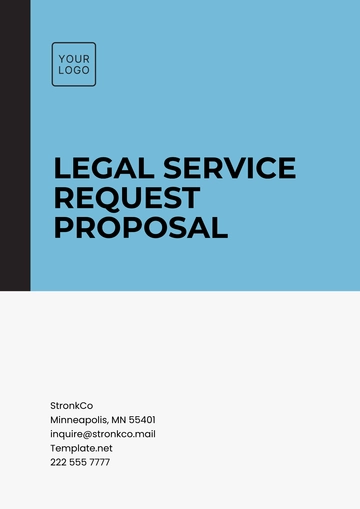Free Law Firm Training Proposal

I. Introduction
A. Overview
As part of our ongoing commitment to excellence and professional development, [Your Company Name] is proposing a comprehensive training program to enhance the skills and knowledge of our attorneys and support staff. This training initiative reflects our dedication to fostering a culture of continuous learning and growth within the firm.
B. Purpose
The primary purpose of this training program is to equip our team members with the necessary tools and resources to excel in their roles and deliver exceptional service to our clients. By investing in professional development, we aim to strengthen our firm's capabilities, enhance client satisfaction, and position ourselves as leaders in the legal industry.
C. Importance of Training
Training is essential in the legal profession to keep pace with evolving laws, regulations, and industry trends. It also helps our team members stay ahead of the curve by mastering new technologies, refining their legal skills, and maintaining compliance with ethical and professional standards. Furthermore, training fosters a culture of collaboration, innovation, and continuous improvement, which are integral to our firm's success.
II. Objectives
A. Enhance Legal Skills
Objective: To improve the legal skills and expertise of our attorneys across all practice areas.
Develop advanced research and analytical skills for effective case preparation and strategy.
Enhance written and oral communication skills for clear and persuasive advocacy.
Strengthen negotiation and conflict resolution skills to achieve favorable outcomes for our clients.
B. Improve Efficiency and Productivity
Objective: To streamline workflows and increase productivity through the adoption of best practices and technology.
Implement efficient case management systems to track deadlines, tasks, and client communications.
Utilize legal technology tools for document automation, e-discovery, and legal research.
Optimize time management techniques to prioritize tasks and meet client needs effectively.
C. Foster a Culture of Continuous Learning
Objective: To instill a mindset of lifelong learning and professional development among our team members.
Encourage participation in continuing legal education (CLE) programs, seminars, and workshops.
Provide opportunities for mentorship, coaching, and peer-to-peer learning.
Recognize and reward individuals who actively pursue personal and professional growth.
D. Ensure Compliance and Ethics
Objective: To uphold ethical standards and compliance with regulatory requirements in all aspects of our practice.
Reinforce awareness of ethical obligations, conflicts of interest, and confidentiality.
Provide guidance on navigating complex legal and regulatory frameworks in various practice areas.
Promote a culture of integrity, honesty, and ethical behavior in interactions with clients, colleagues, and stakeholders.
III. Target Audience
A. Associates
Junior Associates: Recently admitted attorneys seeking to build foundational legal skills and gain practical experience.
Mid-Level Associates: Experienced attorneys looking to expand their expertise and advance their careers within the firm.
Senior Associates: Seasoned practitioners assuming leadership roles and mentoring junior colleagues.
B. Partners
Equity Partners: Firm leaders responsible for client representation, business development, and strategic decision-making.
Non-Equity Partners: Senior attorneys recognized for their contributions to the firm's success and client service.
C. Support Staff
Legal Assistants: Administrative professionals providing essential support to attorneys in case management, document preparation, and client communication.
Paralegals: Certified professionals assisting attorneys with legal research, drafting, and case coordination.
Administrative Staff: Office managers, receptionists, and other support personnel contributing to the smooth operation of the firm.
IV. Training Topics
A. Legal Skills
Training Topic | Description |
|---|---|
Legal Research | Advanced techniques for conducting thorough legal research and analysis. |
Legal Writing | Strategies for drafting clear, concise, and persuasive legal documents. |
Oral Advocacy | Techniques for effective oral advocacy in courtroom proceedings and client meetings. |
B. Technology Training
Training Topic | Description |
|---|---|
Document Management | Utilization of document management software for organizing, storing, and retrieving legal documents. |
e-Discovery | Best practices for conducting electronic discovery and managing large volumes of digital evidence. |
Cybersecurity Awareness | Training on cybersecurity protocols, data privacy laws, and protection against cyber threats. |
C. Professional Development
Training Topic | Description |
|---|---|
Time Management | Strategies for prioritizing tasks, managing deadlines, and optimizing productivity. |
Client Relationship | Techniques for building and maintaining positive client relationships and delivering exceptional service. |
Leadership Skills | Development of leadership competencies for effective team management and firm leadership. |
D. Ethics and Compliance
Training Topic | Description |
|---|---|
Legal Ethics | Review of ethical rules, professional responsibilities, and conflicts of interest in legal practice. |
Regulatory Compliance | Understanding of regulatory requirements, reporting obligations, and risk management in various practice areas. |
Confidentiality | Guidance on safeguarding client information, attorney-client privilege, and confidentiality agreements. |
V. Training Methods
A. Workshops
Description: Interactive sessions led by experienced attorneys and external experts, providing hands-on learning experiences and opportunities for skill development.
Benefits: Facilitate peer-to-peer learning, foster collaboration, and allow for real-time feedback and discussion.
Example: Legal writing workshop featuring practical exercises, case studies, and peer critiques.
B. Seminars
Description: Presentations on specific topics by subject matter experts, followed by question-and-answer sessions and group discussions.
Benefits: Offer in-depth insights into specialized areas of law, provide opportunities for knowledge sharing, and encourage active engagement from participants.
Example: Seminar on recent developments in intellectual property law presented by a guest speaker from a leading law firm.
C. Webinars
Description: Online training sessions accessible to participants via web conferencing platforms, allowing for remote participation and flexibility.
Benefits: Overcome geographical constraints, accommodate busy schedules, and provide on-demand access to training materials and recordings.
Example: Webinar series on legal technology tools and trends, featuring demonstrations and expert panel discussions.
D. Mentoring
Description: Pairing junior attorneys with experienced mentors who provide guidance, support, and career development advice.
Benefits: Facilitate knowledge transfer, promote professional growth, and build strong mentor-mentee relationships within the firm.
Example: Formal mentoring program matching junior associates with partners based on practice area interests and career goals.
VI. Training Schedule
The training program will be conducted over a period of six months, with sessions held bi-weekly on Fridays from 2:00 PM to 4:00 PM. A detailed schedule will be provided to participants prior to the start of the program, outlining the dates, times, and topics for each session. The schedule will be designed to accommodate participants' workloads and minimize disruptions to client service.
VII. Resources Required
A. Financial Resources
Budget allocation for training materials, instructor fees, venue rental, and technology expenses.
Estimated budget breakdown:
Instructor fees: $[000]
Venue rental: $[000]
Training materials: $[000]
Technology expenses: $[000]
B. Personnel
Trainers, facilitators, and support staff to organize and coordinate training sessions.
Assignment of responsibilities:
Training Committee: Oversight and coordination of training initiatives.
Instructors: Subject matter experts responsible for delivering training sessions.
Administrative staff: Assistance with logistics, scheduling, and participant communications.
C. Facilities
Access to conference rooms equipped with audiovisual technology and internet connectivity.
Reservation of meeting spaces:
Conference Room A: Capacity for up to 50 participants, equipped with projector and whiteboard.
Conference Room B: Capacity for up to 20 participants, equipped with video conferencing capabilities.
D. Technology
Computers, projectors, and audiovisual equipment for presentation purposes.
Access to web conferencing platforms for hosting online training sessions.
Technical support services for troubleshooting and assistance during training sessions.
E. Materials
The task involves the printing and distribution of training materials, the provision of handouts, and the creation of reference guides that are specifically crafted for the participants.
The provision of resources online, the inclusion of training manuals for better understanding, and enabling access to various digital platforms for learning and development.
Sample materials:
Legal research guides
Writing style manuals
Technology toolkits
VIII. Evaluation Plan
A. Pre- and Post-Training Assessments
Prior to initiating any form of training, comprehensive assessments are conducted. These assessments are intended to gauge the participants' baseline knowledge, understand their current skills set and identify their individual learning objectives. This is done to ensure the training is tailored to enhance their knowledge gaps and improve their skills efficiently.
After the completion of the training program, assessments are carried out to evaluate how effective the program was and also to identify any areas where improvements could potentially be made.
Evaluation criteria:
Knowledge acquisition
Skills application
Participant satisfaction
B. Surveys
We have to distribute feedback surveys among the participants, so we can gather their opinions, suggestions, and insights related to the training program. This will allow us to understand their perspective and use their input to improve future versions of the program.
Survey questions:
Rate the effectiveness of the training sessions.
Identify topics of interest for future training programs.
Provide suggestions for improvement.
C. Performance Metrics
The process involves tracking of various key performance indicators (KPIs). These indicators are closely related to multiple aspects such as the level of engagement of participants, the rate at which participants are able to retain the knowledge they have gained, and the progress that participants are making in their development of new skills.
Performance metrics:
Attendance rates
Completion of assigned tasks
Client feedback and satisfaction scores
IX. Implementation Plan
A. Formation of Training Committee
The establishment of a cross-functional team is comprised of representatives from various key departments. These include the Human Resources department, several practice groups from diverse fields within the organization, and members of the senior management team.
Responsibilities of the Training Committee:
Development of training agendas and materials
Coordination of logistics and scheduling
Monitoring of participant progress and engagement
B. Development of Training Agendas
Creation of detailed agendas for each training session, outlining the topics, learning objectives, and activities.
Collaboration with subject matter experts to ensure content relevance and alignment with firm objectives.
Distribution of agendas to participants in advance of each session for preparation.
C. Communication Plan
Communication of training schedules, expectations, and logistical details to all participants via email, intranet announcements, and staff meetings.
Provision of regular updates and reminders to ensure participant engagement and attendance.
Accessibility of training materials and resources through the firm's internal portal for easy reference.
D. Coordination of Logistics
Booking of venues, equipment, and technology resources for training sessions.
Arrangement of catering services for refreshments and meals during longer sessions.
Coordination with external trainers, guest speakers, and vendors as needed.
E. Monitoring and Evaluation
Ongoing monitoring of participant engagement, satisfaction, and performance throughout the training program.
Collection and analysis of evaluation data to assess the effectiveness of the training initiatives.
Implementation of continuous improvement strategies based on evaluation results and participant feedback.
X. Conclusion
In conclusion, the proposed training program embodies our firm's commitment to excellence, professional development, and client service. By investing in the skills, knowledge, and well-being of our team members, we are positioning ourselves for long-term success and growth in the dynamic legal landscape. We look forward to the implementation of this training program and the positive impact it will have on our firm and our clients.
- 100% Customizable, free editor
- Access 1 Million+ Templates, photo’s & graphics
- Download or share as a template
- Click and replace photos, graphics, text, backgrounds
- Resize, crop, AI write & more
- Access advanced editor
Manage your law firm's training initiatives effortlessly with the Law Firm Training Proposal Template from Template.net. This editable and customizable template features an intuitive AI Editor Tool, enabling you to tailor your proposal to your firm's specific needs. Streamline your training program planning process and ensure maximum impact with this user-friendly template.
You may also like
- Business Proposal
- Research Proposal
- Proposal Request
- Project Proposal
- Grant Proposal
- Photography Proposal
- Job Proposal
- Budget Proposal
- Marketing Proposal
- Branding Proposal
- Advertising Proposal
- Sales Proposal
- Startup Proposal
- Event Proposal
- Creative Proposal
- Restaurant Proposal
- Blank Proposal
- One Page Proposal
- Proposal Report
- IT Proposal
- Non Profit Proposal
- Training Proposal
- Construction Proposal
- School Proposal
- Cleaning Proposal
- Contract Proposal
- HR Proposal
- Travel Agency Proposal
- Small Business Proposal
- Investment Proposal
- Bid Proposal
- Retail Business Proposal
- Sponsorship Proposal
- Academic Proposal
- Partnership Proposal
- Work Proposal
- Agency Proposal
- University Proposal
- Accounting Proposal
- Real Estate Proposal
- Hotel Proposal
- Product Proposal
- Advertising Agency Proposal
- Development Proposal
- Loan Proposal
- Website Proposal
- Nursing Home Proposal
- Financial Proposal
- Salon Proposal
- Freelancer Proposal
- Funding Proposal
- Work from Home Proposal
- Company Proposal
- Consulting Proposal
- Educational Proposal
- Construction Bid Proposal
- Interior Design Proposal
- New Product Proposal
- Sports Proposal
- Corporate Proposal
- Food Proposal
- Property Proposal
- Maintenance Proposal
- Purchase Proposal
- Rental Proposal
- Recruitment Proposal
- Social Media Proposal
- Travel Proposal
- Trip Proposal
- Software Proposal
- Conference Proposal
- Graphic Design Proposal
- Law Firm Proposal
- Medical Proposal
- Music Proposal
- Pricing Proposal
- SEO Proposal
- Strategy Proposal
- Technical Proposal
- Coaching Proposal
- Ecommerce Proposal
- Fundraising Proposal
- Landscaping Proposal
- Charity Proposal
- Contractor Proposal
- Exhibition Proposal
- Art Proposal
- Mobile Proposal
- Equipment Proposal
- Student Proposal
- Engineering Proposal
- Business Proposal
















